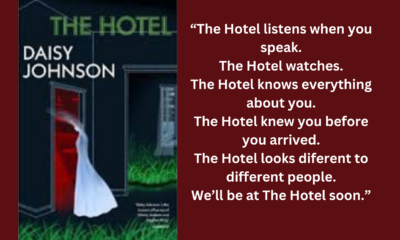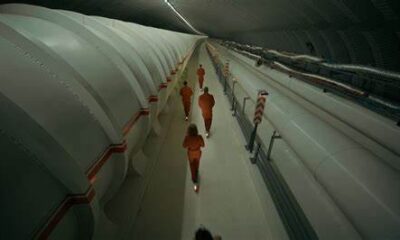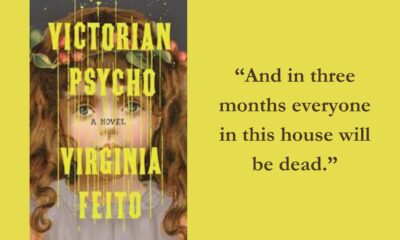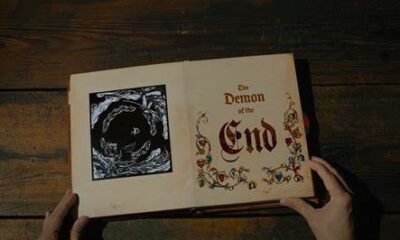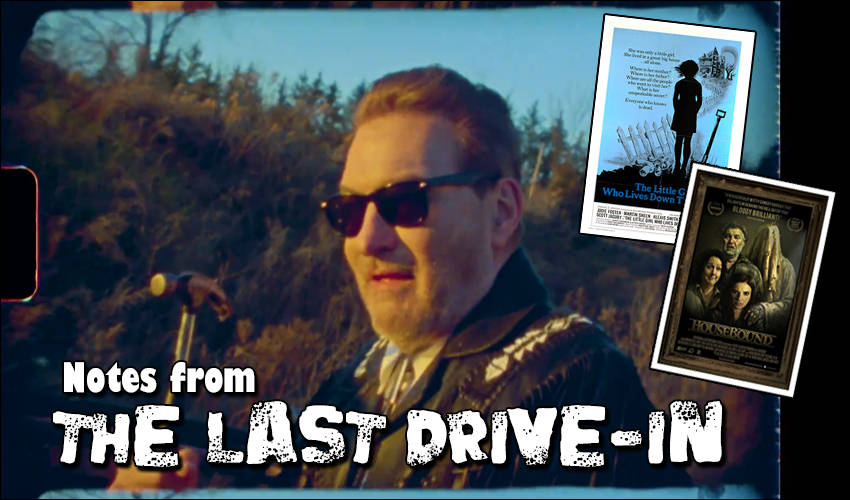
Notes from the Last Drive-In: S4E3 – ‘The Little Girl Who Lives Down the Lane’ and ‘Housebound’
More Videos
Published
3 years agoon
We head back to the drive-in with Joe Bob and Darcy this week to watch The Little Girl Who Lives Down the Lane (1976) and Housebound (2014). Lock your doors and stay inside with Shudder, because this Friday the 13th double-feature is agoraphobic-approved.
We pick up from last week’s Walpurgisnacht fun to another creepy day for horror nerds, and along the way, we learn some cool history about superstition. But does the theme land, or does this week’s double-feature premise feel a little thin?
You know the first date is going well when she shows you where she hides the bodies.#thelastdrivein @therealjoebob @kinky_horror @shudder
— Haunted MTL 🏳️🌈 (@HauntedMTL) May 14, 2022
The Little Girl Who Lives Down the Lane (1976)
New England always seems like a goth paradise.#thelastdrivein @therealjoebob @kinky_horror @shudder
— Haunted MTL 🏳️🌈 (@HauntedMTL) May 14, 2022
The Little Girl Who Lives Down the Lane is a 1972 “cross-genre” film with elements of a teen drama, thriller, horror, and character study. It is certainly no feel-good film, either. It is a dark satire of the worst fears of parents subverted by a protagonist who has lived more than most adults. Directed by Nicolas Gessner, the film stars Jodie Foster, Martin Sheen, Alexis Smith, Mort Shuman, and Scott Jacoby. The film is a Canada/French-produced adaptation of Laird Koenig’s novel of the same name. The film would be written by Koenig.
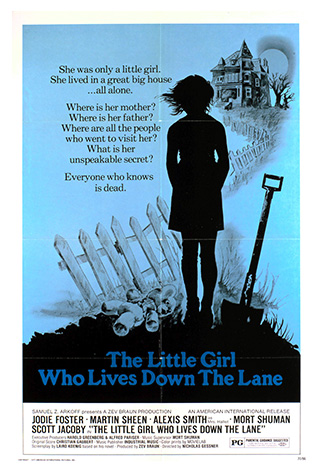
The plot is simple; a thirteen-year-old girl named Rynn (Jodie Foster) lives in apparent isolation in the town of Wells Harbor, Maine. Her apparent isolation draws the curiosity of the community, including that of a local pedophile, Frank (Martin Sheen), the son of Rynn’s landlord, Cora (Alexis Smith). Rynn’s privacy is repeatedly under assault by the larger community and the obsession of Frank as her father, a poet, is never seen by locals. A chance encounter with a young man, Mario (Scott Jacoby), nephew of local cop Ron (Mort Shuman), unravels the complicated and tragic circumstances behind Rynn’s apparent isolation.
This is not a pleasant film, not in the sense that it is not a good film, but in the sense the mood is oppressive and the world depicted is cruel and unfair. The film frustrated me several times because of what liberties adults take against a child in her own home, against her wishes. The writing in this regard is excellent, with several great moments of conversation. This is one of the “talkiest” films shown on The Last Drive-In, perhaps akin to The Changeling. The film itself is limited in scope as well, mostly playing out within Rynn’s house. The story’s limitations reveal the intent of Koenig, the writer, who originally sought to adapt his novel into a play. I would love to live in a world where The Little Girl Who Lives Down the Lane was a theater staple.
The film is tightly written with a fairly efficient run time, though two montages cause the film to drag a bit. This is also compounded by the use of Chopin’s piano concerto No. 1 in E Minor, as performed by pianist Claudio Arrau and The London Philharmonic Orchestra. Chopin’s composition overpowers the film score by Mort Shuman and Christian Gaubert. It feels odd to say, but the use of Chopin seems a little much and is used so frequently that having repeated through montages makes them feel longer due to simple aural repetition.
The film’s cinematography is fine, but René Verzier’s work does not do much to sell the film as needing a film adaptation. The quality and the cinematography are fairly rote. Most of the tension comes from performances with little added effect from Verzier’s camera.
The performances are largely excellent, and the critical praise of Jodie Foster, who was twelve as the production began and then turned thirteen during, is well deserved. Foster is one of the finest actresses to ever work in film and seeing her command the screen so readily is impressive. You feel anxiety for her and can’t help but feel broken at the end of the movie because of how wonderful she is.
Sheen is a revelation as well, only three years away from the role that would cement him as Hollywood royalty in Apocalypse Now. Frank as a character is so manic and aggressive in such a weirdly charismatic way. Imagine the worst person in the world with leading man looks and charm, and you get a sense of just how insidious and dangerous the character of Frank is. The truth is, we are lucky to see such a top-tier actor play such a horrific character.
Now, singing the praises of Foster and Sheen is not to say the rest of the cast does not deliver. Alexis Smith’s Core Hallet is an icy busybody who takes her sparring with a child personally, and her brief time in the film results in wonderful dialogue with Foster’s Rynn. Scott Jacoby plays the handsome and charismatic weirdo, Mario, who creates a bright spot in the overall dark life of Rynn. And not least, Mort Shuman’s Officer Ron Migliorti represents a gentle, good man who tries to help but is kept at arm’s length.
Joe Bob-servations on The Little Girl Who Lives Down the Lane
Joe Bob’s host segments were a lot of fun this week, especially with the recurring discussion on superstition. Perhaps the best of the night came early when he discussed the origins of The Thirteen Club. The whole history was quite fascinating, but also gave way to one of the best laughs of the night: when he cracked a joke about everyone in the club dying, catching Darcy off-guard. The whole night was filled with interesting little asides into the superstitious mind.
Regarding the film, Joe Bob was quite effusive with his praise, as the film deserves. Of the various aspects, he discussed, however, he was particularly vocal about how this film was very much lucky to cast who it had and the time it was made. You get the sense that maybe The Little Girl Who Lives Down the Lane couldn’t be made today and have quite the impact it did with the one-two punch of Foster and Sheen. Regarding Foster, Joe Bob made a very important point: by the time she was twelve she had already had a strong career as a child actress, so her professionalism in the film isn’t overly surprising as some make it out to be.
Final Thoughts on The Little Girl Who Lives Down the Lane
The Little Girl Who Lives Down the Lane is a largely excellent film, among some of the best of the ‘serious’ films that have been shown on the show. The nature of the film as being like that of a play may limit the audience a bit, given how dialogue-heavy it is, but for those who can manage there is a lot to love.
The film does drag at times given the overly artsy montages set to classic Chopin compositions, and the internal logic does frustrate at times given the number of privacy and property violations that seem to occur over the duration of the film. It gives one the impression that maybe the oppressiveness is a more heightened element than was necessarily true. It does certainly inspire a reaction, however. As I was not alive in the 1970s I would love to know the accuracy of how the characters would have behaved from someone who was.
Joe Bob gave the film 3 and 1/2 stars, which seems about right. I feel that perhaps the half-a-star deduction was due to the arthouse quality, as this is a drive-in show. Mutants can only go sophisticate for so long a stretch. As for me, I’d about where Joe Bob is regarding my assessment, giving the film 4 and 1/2 Cthulhus out of 5.
 (4.5 / 5)
(4.5 / 5)
Best Line: “School is having people tell you what life is and never finding out by yourself.” – Rynn
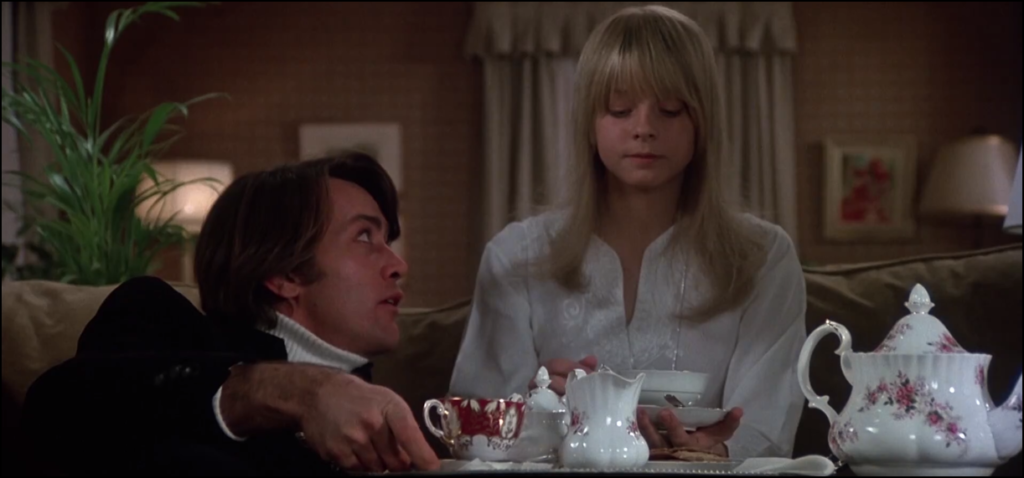
Housebound (2014)
"I can't help it I'm bottom heavy, alright?!"#thelastdrivein @therealjoebob @kinky_horror @shudder
— Haunted MTL 🏳️🌈 (@HauntedMTL) May 14, 2022
Housebound was the night’s second feature. This 2014 New Zealand horror comedy was written, edited, and directed by Gerard Johnstone. The film made its debut at SXSW where it quickly became an indie darling. The film was a New Zealand accelerator project where government funding was granted in order to assist in the production. The film stars Morgana O’Reilly, Rima Te Wiata, Glen-Paul Waru, and Cameron Rhodes.
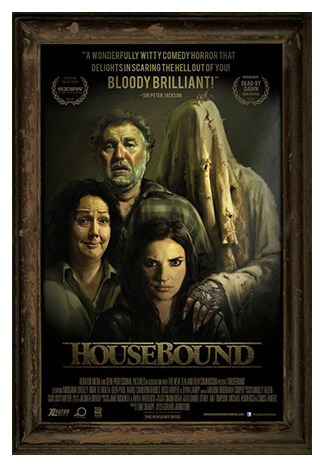
Housebound follows a troubled young woman, Kylie Bucknell (Morgana O’Reilly), who botches an ATM robbery and is sentenced to house arrest for eight months under the care of her mother, Miriam (Rima Te Wiata). Stuck at home with an ankle monitor, Kylie and her mother discuss past instances of hauntings that seem to trigger an awareness of strange things going on within the house. However, Kylie uncovers more about the strange circumstances of the home with the aid of her parole officer, an amateur paranormal investigator, Amos (Glen-Paul Waru), and the guidance of her psychologist, Dennis (Cameron Rhodes).
The film is quite funny but is fairly light on the scares and gore, despite a particularly explosive death that results in a shower of blood. The film was quite critically appraised at the time of release and made waves in the American film industry, but today you do not hear much about it, nor do you hear much about the man behind it, Gerard Johnstone. Indeed, the film seems largely forgotten, which is a bit of a shame given the fresh approach it takes, but also a bit expected in that it doesn’t quite land the punches it throws.
The film’s approach to subverting the haunted house theme is clever at first until contrivances and dialogue dumps begin to drag down what started as a rather tight little haunted house project. The foundation that was so strong progressively begins to look like a tower of Jenga blocks the further on the film goes and the revelation within are clever, but I struggle to say they’re necessarily worth the ride. For example, the Teddy Ruxpin knock-off makes absolutely no sense in the context of the film when all is revealed. Having seen the film twice I am still failing to understand why the bear was able to do what it did, even if it had a “helping hand.” This may be one of the most glaring issues with the logic of the film, in my opinion. That being said, the film has a number of them.
My other big criticism of the film is that the protagonist is unlikeable. A protagonist does not need to be likable to be compelling, but there needs to be some reason to want to follow their journey. I think Morgana O’Reilly is fine as Kylie, but Kylie is such a shit that it is largely hard to root for her. Nor does there seem to be a real sense of growth in her character either as most of the decisions in the final act are largely driven by survival impulses and leave little room for a sense of growth. Rather, the film’s most appealing characters are Amos and Miriam. Amos because he is a weird, earnest dude, and Miriam because Rima Te Wiata does a fantastic job playing a mother abused by her child.
Simon Riera’s cinematography is effective, but nothing particularly outstanding. It is serviceable for the type of film this is. There is a fun moment where Dennis is menaced by the ‘spirit’ of the house and the sequence set across an entirely blacked screen flashes to a chilling reveal of the spirit hovering over the psychologist. A scene involving dentures is also suitably framed to be as uncomfortable as possible, which I appreciate as someone who has a particular fascination with teeth as a vehicle for horror. As for Mahuia Bridgman-Cooper’s score, I found it to be effective, but nothing that really pulled me in, either.
Ultimately, I think the description of “effective but did not pull me in” is an encapsulation of my overall attitude regarding this film. It was, for lack of a better word, fine.
Joe Bob-servations on Housebound
The survey of superstitious carried on into the second film of the night with digressions into rabbits’ feet and the potential origins of the term “knock on wood.” What felt lacking was a real example of the connection of either film to superstition. The connective tissue was the idea of refusing to leave the house, but neither film presented the shut-in nature of their leads as being tied to superstitious anxieties.
Of course, with any New Zealand-sourced film on the show, Joe Bob returns to beating his drum on the misappropriation of the terminology “Kiwi horror” as it relates to the film in question, just as he did back with Deathgasm. In case you missed it with previous horror films out of New Zealand on the show… “Kiwi horror” does not exist – it is not a distinct genre, it is just a label attached to films made out of New Zealand with incubator money during a period of time and there is nothing particularly of New Zealand about them.
Expect to hear that same point again the next time a movie from New Zealand is shown.
Final Thoughts on Housebound
Housebound is a fun mid-2010s horror film out of New Zealand with a clever play on the haunted house trope, but cleverness isn’t enough to win me over completely. Between a thoroughly unsympathetic protagonist, an overly convoluted series of backstory reveals, and the fairly limited amount of horror, I would be hard-pressed to claim this among my favorite on The Last Drive-In. I didn’t really feel a sense of shock or dread. Granted, I was entertained, but the film didn’t blow my mind. The same can’t be said for one of the characters, that’s for sure.
Joe Bob gave the film the 2 and 1/2 stars treatment. I think that is entirely reasonable. It’s worth a watch, but it doesn’t seem like one that will stick with me and other Mutants of my ilk. As for my assessment, I would give it 3 Cthulhus out of 5.
 (3 / 5)
(3 / 5)
Best Line: “You cannot punch ectoplasm.” – Amos
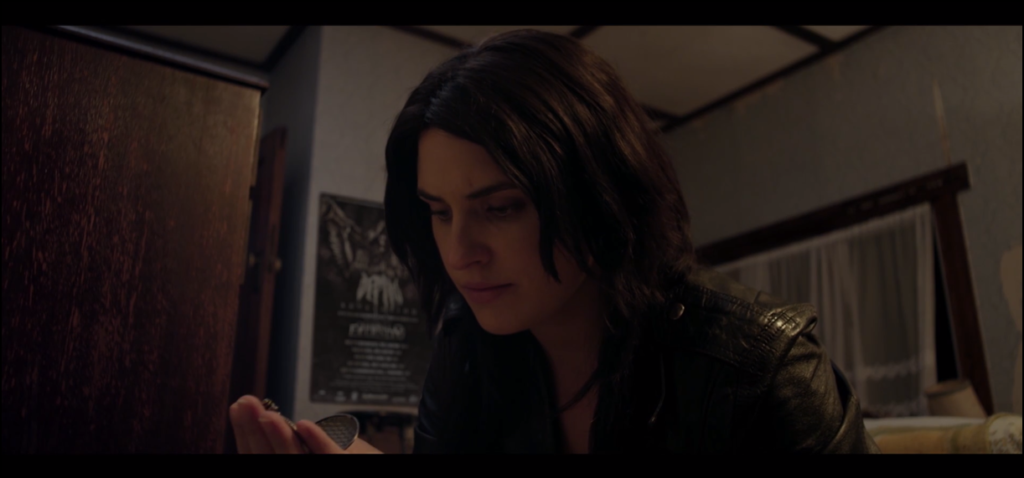
Haunted MTL Drive-In Totals
As for the official drive-in totals, we have the following.
Sorry folks, the hamster doesn't make it. Advance warning. #TheLastDriveIn pic.twitter.com/1i8gEFsI7F
— Shudder (@Shudder) May 14, 2022
Denture Theft 🔜 Denture Fu #TheLastDriveIn pic.twitter.com/WGPyQWrlPv
— Shudder (@Shudder) May 14, 2022
We also have the Haunted MTL Drive-In totals…
- 1 Fangoria Chainsaw Award for Achievement in Non-Fiction
- 1 Dead Hamster
- 2 Moody Montages
- 3 instances of “Thee-ate-er”
- Clipboard Fumbling
- Superstition Tempting
- Heaven Joking
- Cocktail Joking
- Gratuitous Plot
- Gratuitous “Hello Moto”
- Child Rights Advocating
- Water Moccasin Anxiety
- Suprise Italian Racism
- John Brennan Musical Number
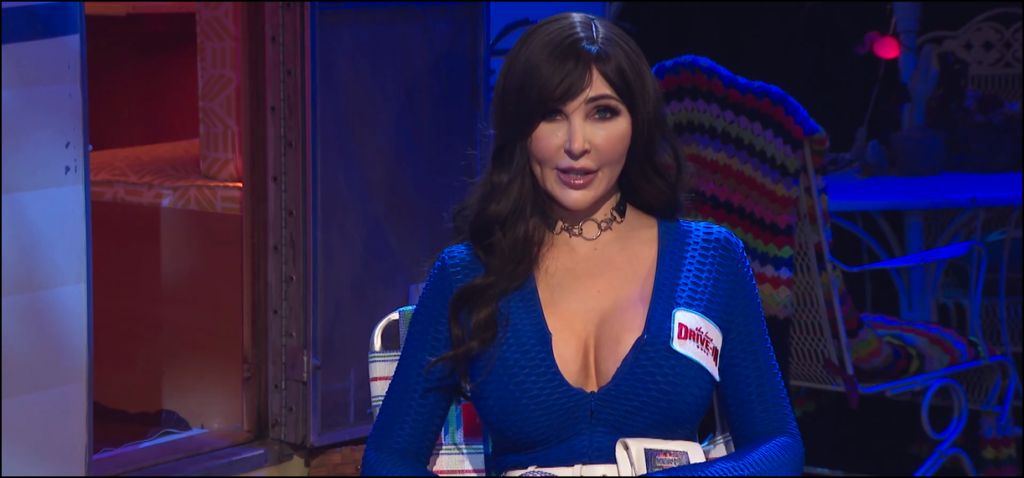
Episode Score for The Last Drive-In: S4E3 – The Little Girl Who Lives Down the Lane and Housebound
I had expressed some doubt about the theme of last week’s double feature, but I am happy to say this double feature’s theme was much more coherent, although admittedly a bit of a stretch. Friday the 13th is a day about superstition, and while that thread was woven in quite well through the host segments, the film selections were tangential – built around the idea of a “shut-in night” for the ultra-paranoid and superstitious.
The only problem was that neither film really dealt with being shut-in due to superstition. One was a girl living by herself trying to do her own thing as the world pushed back at her and the other is about someone under house arrest. The host segments were fun, but I am wondering if stating a theme outright is the right route to go down with these episodes. Perhaps if the themes were stated as being more open-ended the double features would gel a bit better through juxtaposition. However, setting an expectation of a theme and not really delivering on it feels like a misstep.
I am probably taking this sort of thing a bit too seriously, but I also think the past two weeks represent a stretch that could lead to misfires in the future. I vastly prefer the themes of the double features being more subtle or interpretative outside of the holiday sets. Soon we’ll find ourselves seeing an environmental awareness pairing where one film is set in the woods and one film has a beach… and that is about it.
The episode as a whole is still great, of course, and the host segments are as fun as ever. Yet, something about the loose associations between the last four films is rubbing me the wrong way.
 (4 / 5)
(4 / 5)
And that is it for Notes from the Last Drive-In this week. This has certainly been a little bit more critical than most of the reviews I’ve done, owing largely to the fact that the show is usually firing on all cylinders the majority of the time. Four seasons and multiple holiday marathons in, however, it would make sense that maybe there are some performance issues to be aware of.
What did you think, though? Why not share your thoughts in the comments with us about the show and the two films shown. Did you have a favorite?
With that, please join us on Twitter next Friday as we live-tweet with the rest of the Mutant Fam during The Last Drive-In with Joe Bob Briggs.
Anyone who played Metal Gear is going like… #TheLastDriveIn @therealjoebob @kinky_horror #MutantFam @HauntedMTL #SnakeInaBox pic.twitter.com/1acYBuLsbn
— Doctor Payne (@DoctorPayne4) May 14, 2022
Love the movie? (Sponsored Link)
Consider purchasing a copy of The Little Girl Who Lives Down the Lane from Amazon. Your purchase through our sponsored link helps Haunted MTL.
David Davis is a writer, cartoonist, and educator in Southern California with an M.A. in literature and writing studies.

You may like
Doctor Who
Identical: Yes. The Same: No – Exploring the World of AI Reconstructions in Doctor Who
Published
2 weeks agoon
March 19, 2025By
J M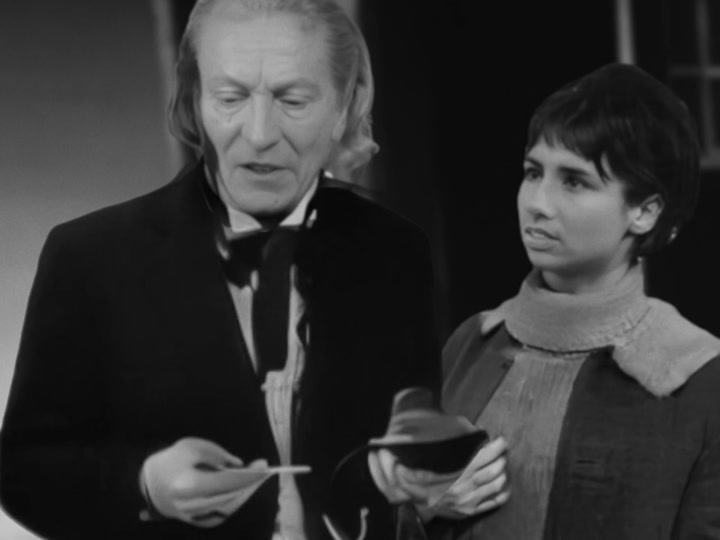
The second half of 2024 was a bit of slow for Doctor Who news. Ncuti Gatwa’s first season finished in June, and the Christmas special was months away. Comics and audio plays continued, and a Blu-Ray set of Season 25 was released – but that was all.
However, what was new and exciting was a spate of unofficial recreations of missing Doctor Who stories from the sixties. Re-animations of missing stories have occurred previously, both officially by the BBC and unofficially by fans. However, animation production time means it’s rare to have more than a few episodes a year. However within the space of six months, forty-four recreated episodes were released, with the promise of more to come.
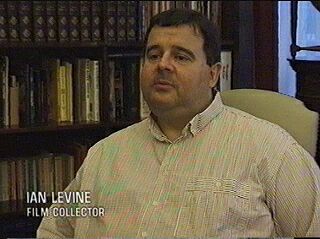
The reason how so many stories have been released so quickly is artificial intelligence (AI). These reconstructions are Generative AI, funded by professional songwriter, film producer, and fan, Ian Levine. This decision to make Doctor Who AI Reconstructions, to put it mildly, has been controversial online.
But is it worth it, in order to having otherwise missing stories returned to us? I’ve examined many of these Doctor Who AI reconstructions, and the discourse around them, to find out.
In Brief – Missing Episodes
A decent proportion of Doctor Who’s earliest years shockingly does not exist anymore. Doctor Who is one of the BBC’s biggest revenue raisers, and most famous show around the world. However it was not always the case.
When Doctor Who first began in 1963, the idea of keeping media was not really considered. Home video did not exist, and would not exist for two decades. Repeats were rare, due to the costs at the time to store old material and pay people involved in them. Also, old film presented a fire hazard. So it was often disposed of.

Despite this, Doctor Who is fairly lucky compared to other series. Firstly, fans at the time recorded the audio of each story. This means even the first ever Christmas Special – “A Feast of Stephen,” never broadcast internationally or repeated, still exists as an audio.
Doctor Who is also lucky because of only six seasons are not complete. In addition, of those six seasons, only half are missing only episodes from one or two stories. This allows us to get a feel for the early years of Doctor Who in a way fans of other series, like “Quatermass” and “The Avengers” aren’t able to. And part of the reason most of these early seasons survive is due to Ian Levine.
Who is Ian Levine?

Ian Levine professionally is a songwriter and DJ. He has written and produced records connected to such bands as Take That, Pet Shop Boys, Bananarama and Bucks Fizz. His total sales exceed 40 million records.
He is also well known as a prominent Doctor Who fan. There are many prominent Doctor Who fans. The series from 2004 onwards has been largely made by prominent Doctor Who fans of the 70’s and 80’s. Many of these fans contribute to Doctor Who in official ways. For instance, many older fans have written books, or audio plays. All three showrunners for the modern series would be considered prominent fans from the nineties. For Ian Levine, his main contribution is seeking to find and restore missing episodes of Doctor Who.
This work started in 1978 where Levine reportedly requested the permanent halting of old episodes of Doctor Who. At the time the idea of home video was being considered, leading to more reasons to keep old film. Levine also claimed to have rescued the first ever Dalek story from being sent into a furnace. Following this, he began purchasing private copies of the remaining stories, and attempting to return them to the BBC.
He also connected with the Doctor Who Production Team of the eighties in other ways. This included composing the theme tune for the spin-off series “K-9 and Company”, and the protest/charity album “Doctor In Distress.” His was also consulted about continuity during seasons eighteen to twenty-two.
However, he also gained a notorious reputation as obsessive in an unappealing way. During the 1985 Doctor Who hiatus, Levine was encouraged by Producer Jon Nathan-Turner to use protest the decision. Levine argued against the decision on television, and smashed his television with a hammer, and inviting newspapers to photograph it.
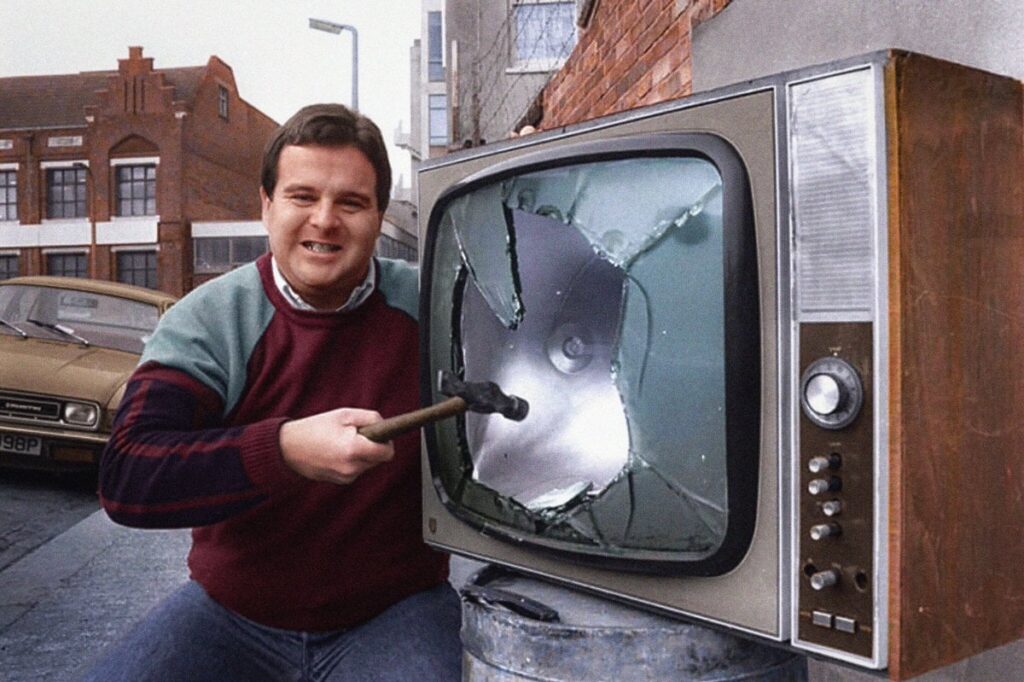
So he is fan who has both done great things, but also sought notoriety and negative attention.
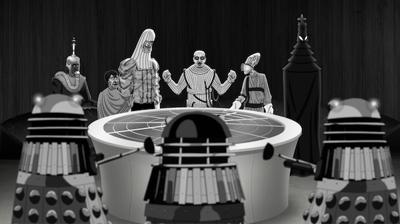
More recently, Levene has worked with animating missing or incomplete episodes. This started in 2010 with “Mission to the Unknown.” This was not allowed to be shared or sold due to it being made without BBC authorization. In 2013, Ian hired an animated reconstruction of the unfinished story “Shada.” This version used pre-existing footage and new audio to create a finished product he hoped could be licensed. However, the BBC chose not to. Instead they made their own animated version that was released four years later.
- Join the Doctor (Tom Baker), Romana (Lalla Ward), and K-9 (voiced by David Brierley) as a visit to a Time Lord living incognito on Earth leads to a desperate race to a distant prison planet
- A BBC strike halted filming of this never-broadcast Baker six-episode serial written by “The Hitchhiker’s Guide to the Galaxy” author Douglas Adams
- Christopher Neame, Victoria Burgoyne co-star
Last update on 2025-03-16 / Affiliate links / Images from Amazon Product Advertising API
Subsequently, Levine made comments regarding Jodie Whittaker as the first female Doctor which were deemed by many to be sexist. Levine responded by publicly quitting the fandom, though later created his own private Doctor Who Facebook group.
This group has now become the location where his AI recreations he has funded and received donations for are shared.
The Doctor Who AI Reconstructions – How to Access
The Facebook Page: “Ian Levine’s Facebook Group” requires an agreement to two questions to join. Firstly, you must agree to respect the right to criticize Jodie Whittaker. Secondly, you must recognise this is Ian Levine’s group for sharing his opinions on Doctor Who. Agree to all this, and you’re allowed in.

Inside the group, Levine has shared around twenty videos. This includesall of “The Dalek Masterplan,” “The Massacre,” and “The Savages.” However for the remainder, you must make a donation of fifty pounds, to become a contributor to the series.
Once your donation is confirmed, you are authorized to join the separate contributors group, for contributors only. This is where all the current videos being made are released.
Except…. None of these videos are unavailable privately. Ian Levine has placed them all on Youtube. They are unlisted, so they cannot turn up in either a Google or YouTube search. However, if you have a direct link or URL to them, they are accessible to everyone. Unlike other systems like Patreon which restrict content to only certain subscribers, nothing stops these links being shared elsewhere.
And of course, these links are shared. In response, Levine has issued threats and warnings against other Facebook groups and leakers trying to destroy his vision. In his group, people support him and join in denouncing those who criticize his work or mock it. People outside the group in response denounce Ian Levine and his supporters.
One thing I hate about internet culture is the push for tribalism. This is the idea we are joined in a selective tribe and must fight the rivals to connect. Over time the views become more strict in supporting your own tribe, and rejecting the opposition, and the middle ground is lost.
In the case of Ian Levine’s group, this is best shown by the view of alternative animations of missing Doctor Who stories. All of these are seen as not as good as Levine’s AI reconstructions. Levine’s reconstructions are seen as the only correct way Doctor Who is meant to be.
Initially Ian Levine’s AI project aimed to complete the ten missing stories not completed by the BBC. The initial project recognised the slow time it took to animate missing stories, and focused on stories that were difficult and costly to animate with people. Very soon after, however, Levine denounced many of the prior animations as “Silly Scooby Doo Cartoons.” The project was quickly extended to include stories previously animated by the BBC. Levine’s argument appears to be Levine’s objections to story changes animation had included. These included adding a surprise image of the Master in “Fury from the Deep”, prior to his debut appearance. Given Levine’s history of making things for the BBC, with the hope the BBC would license them, there have been rumours Levine initially was hoping the BBC would license some of his AI recreations, which has not come to pass.
Levine presents his animations as the most authentic way to view the missing episodes. Therefore appreciation of official animated reconstructions are not allowed. A poster saying they enjoyed the animated version of “The Celestial Toymaker,” was informed by Levine tht anyone who enjoyed the animation was unwelcome. Common responses of new animations being announced are people accusing the BBC of ruining another story. When Levine had a fault pointed out in one of his stories by Frazer Hines, who played the second Doctor’s companion, Jamie, Levine’s first response was to accept that the animation had limitations, but insisted it was still better than any animation the BBC has made. Most of all, posters all reinforce the message that AI reconstructions are the true version of the lost stories and the BBC are fools for not paying for them.
- The Celestial Toymaker sees the Doctor and his companions separated when they come up against the Toymaker
- While the Doctor plays the Trilogic Game, Steven and Dodo are forced to play their own seemingly childish, but ultimately dangerous games, with the aim of being reunited and getting back to the TARDIS
- Who will be the first to make a false move in this battle of wits, and will the TARDIS ever escape the Toymaker’s snare Fans of Doctor Who have long lamented the loss of the original 1966 master recordings of all except one of The Celestial Toymaker
Last update on 2025-03-16 / Affiliate links / Images from Amazon Product Advertising API
In response to this, or provoking this, depending on your point of you, external Facebook groups and YouTube channels are highly critical of the AI reconstructions. Some videos see them as threats, preventing the BBC from every investing in animation involving real people. Some hav dismissed the project as a scam.
So with such strong opinions on both sides, it’s time to actually watch them.
The AI Reconstructions

My first response on watching is they’re not that bad, but they’re not that good. Animation varies wildly in quality from story to story, making it hard to tell an overall trend towards or away from quality. However there are some good examples of how to recreate a story. “The Massacre” and “The Dalek Masterplan” for instance are incredible to watch. “The Savages” on the other hand is laughingly bad.
I chose to mostly focus on the stories not yet officially animated, so as to judge these stories by their own merit rather than compare to other animated versions of the same stories. However, it’s interesting the similarities that occur between the official animations and AI reconstructions. Non human characters (Particularly Daleks) look and move great, but people largely do not.
Animating People
Across most forms of Missing episode recovery, whether AI or human drawn, the difficulty is always animating people to show emotions and movement. Many of the official BBC animations often leave characters looking like stick figures bobbing up and down.
However one of the key things the official reconstructions provide is consistency. A human being develops a pre-existing model for characters, and because of this, these characters stay consistent over time.
AI on the other hand appears to forget things, or lose focus unless properly guided. People’s faces can change dramatically from shot to shot to the point, as in “The Savages” characters can be unrecognizable. This means, unlike with official animations, I often had to follow a story summary to figure out what was going on.
AI also forgets smaller things that make people seem human. In “The Highlanders” for instance the Doctor’s companion Polly does not blink for most of episode one, despite being in shot. This is a small detail, but throws the story into the uncanny valley – characters involve look like people but they feel wrong based on how they act.
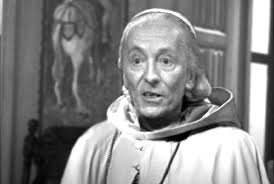
Movement is a struggle for all reconstructions because human movement is difficult to animate. Once again, “The Massacre” demonstrates small examples of movement than seem fluid, particularly in the first episode. “The Savages” on the other hand has main characters seemingly to perform scissor jump spread legged when the script call on them to walk.
How the animation occurs

Having watched many of these animations, some of means AI generated these reconstructions became clearer. A lot of these animations, especially some of the later ones, do not actually generate much new material, instead using existing material in different ways. The First Doctor saying goodbye to Susan in the TARDIS, from Episode 6 of the Dalek Invasion of Earth, for instance is frequently re-used. This scene is redubbed multiple times in the reconstructions, when a missing story needs a scene of William Hartnell standing alone in the TARDIS.
Another method is using the telesnaps, and slightly animating the mouth and face. This creates a sense of fluidity and movement, but a very limited one. This is particularly noticeable in the Space Pirates. The resconstructions rely on switching between static photos of one cast member with mouths moving. On the one hand, this is no worse than the telesnaps, but the telesnaps were aware of their limitations, so often would use narration or subtitles to fill the gaps. However these reconstructions are presented as the most life like renditions of the missing episodes. As the original story did not have subtitles or narration, therefore, they are not allowed. As a result the story is incomprehensible.
Benefit – it exists
But despite the complaints, there is a significant benefit in these reconstructions. And that’s the fact that they exist.
Currently nine missing stories have not been officially animated by the BBC. I would love for all missing stories to be animated. However, the reality is most of the stories remaining might be too costly to animate.
Of the nine stories, six are pure historicals – stories with no science fiction elements apart from the TARDIS and its crew. These stories tended to have a larger number of human characters than stories with monsters, and a human being with their range of emotions is harder to animate than a Dalek.
Historicals also tend to have more detailed and complex scene change. A story in the future can replicate cold, grey corridors throughout a space colony. Historicals however must recreate significant locations in the world at particular times in history. Having to recreate 15th century France, for instance, is made up of multiple distinct locations. This makes historical stories more time consuming and therefore costly to animate. Therefore, despite stories being reanimated for almost twenty years now, the total number of historical episodes animated have been two – both missing episodes of the Reign of Terror.
For the remaining three stories, the limited human cast and isolated space station locations makes Wheel in Space relatively simple to animate. The Space Pirates, may also be animated as the story focusing mostly on space ships should make some aspects of the design easier to manage.
That just leaves The Dalek Masterplan¸ a massive twelve episode story, with a one episode prequel, where the Daleks chase the Doctor throughout time and space. The cast is huge, and while it is not a historical, the story would require animated sets of ancient Egypt during the building of the pyramids. None of this would be easy to do on the current BBC animation budget.
Therefore, it appears of the remaining nine missing stories, only two are highly likely to be animated.
And this is where AI can play a role. As AI does not rely much people, it means the costs to recreate a story like the Dalek Masterplan is significantly easier and cheaper than hiring a production studio to make it. While the end result is not as good as a professionally animated episode, for stories where hiring professional animations is not feasible, this is one way for people to observe a version of a story we otherwise cannot access.
Ultimately the frustrating thing about these reconstructions is they’re not allowed to be what they are. If they were simply an attempt to make otherwise lost stories more accessible, without any pretention or idea of superiority they would be fine. There are no shortages of fan made reconstructions, which vary in quality, but are all warmly received because they don’t pretend to be more than fan made animations. They are no better or worse than any other reconstructions.
If Levine’s reconstructions were presented with the same humbleness, the response would be more positive. If Leveine would present it as a project, and be accepting of others not needing to accpet them, there would be less retaliation online. But they aren’t presented as a fun way to view a loss episode. The reconstructions are presented as the only correct way to view the stories, superior than any other effort. In fact, he considers the stories no longer lost due to his AI reconstructions.
But by doing so, he puts the reconstructions on a pedestal of perfection. But they aren’t perfect, not by a long shot. By Leveine presenting these as perfect, he ultimately encourages people to notice how they are lacking by comparing to perfection. In comparison, more humble attempts of reconstruction, by presenting themselves as not the best, encourage people to notice what they do right.
So, try to enjoy the reconstructions for what they are. Some are surprisingly good – especially The Dalek Masterplan and The Massacre, and it’s a chance to see stories animated that you may not get to see animated elsewhere. But try to filter out all the rhetoric about how amazing and perfect they should be, and just enjoy them as they are.
 (2 / 5)
(2 / 5)
Related posts:
Movies n TV
Wheel of Time A Question of Crimson Is a Political Espionage Delight
Published
2 weeks agoon
March 17, 2025Episode two of Wheel of Time felt like the beginning of a long journey. Stories are unfolding, lives are changing, and blood is spilling.
Let’s discuss.
The story
We begin this episode in the past with Elayne’s mother, Queen Morgase. It turns out her rise to the throne was a bit, shall we say, cutthroat. So when she shows up at the White Tower, Siuan is concerned.
She might have reason to be, too.
Meanwhile, Rand, Egwene, Moiraine, Lan and Aviendha are in the Spine of The World. As they travel through some of the most breathtaking lands I have ever seen on a TV show, Egwene is plagued with nightmares. We think at first that’s just her trauma working itself through her system. But we soon find out that it might not be that straightforward.
Finally, Perrin returns home to heal after his hand is almost cut in half. But when he gets there he finds the town has been infested by Children of The Light. And they’re looking for him.
What worked
There was something heartwarming in this episode about political espionage and choking religious persecution. And that is Elayne’s relationship with her family.
I have consumed a lot of fantasy content with royal families. And I have never once heard a princess call her mother ‘Mum’. I’ve never seen royal siblings get along. And I have sure as hell never seen a princess have a good relationship with her step-parent.
This was refreshing. Even though Queen Morgase is kind of a horrible person she seems like a good mother. And that’s an unexpected delight.

Of course, this is just one storyline among many. And while this can sometimes be overwhelming, in this case it wasn’t.
I’ll be honest, some of these storylines are going to drag for me. I know this because I’ve read some of the Wheel of Time books and I have an idea that not all the characters exactly pique my interest.
No one likes all the characters. No one likes all the storylines. While I am here for the political espionage between Queen Morgase and Siuan, not everyone likes it. While others might be fascinated with Selene trying to win Rand back, I couldn’t care less.
Having multiple storylines keeps everyone’s attention better. So long as things don’t get out of hand. Things can easily get out of hand. But this seems to be managed well.
So far.
What didn’t work
As I mentioned above, I’m not thrilled with Rand’s story at this point. And while it’s fine to not like a storyline when there are this many to choose from, it’s not fantastic that the one I like the least is the one involving our two main characters. And anytime we were with the team at the Spine of The World, the only thing that brought me joy was Moirain’s hat. It reminded me of Stockard Channing’s hat in Practical Magic.
The problem is that Rand is Charlie Brown with controversial magical powers. He is boring, serious, and pessimistic.
And yes, I understand that he has a heavy emotional burden and he’s the Dragon Reborn and that’s quite taxing and all. But let’s be fair, there isn’t a single person in this show that doesn’t have a heavy burden. And most of them manage to be fun occasionally.

All that being said, this episode of Wheel of Time did exactly what it needed to do. It set up conflicts at each of the three locations. It established emotional ties between the characters and the events. And it established goals for everyone.
This was, in short, a solid episode. Not groundbreaking, not mind-blowing or life changing. It was simply good. It was entertaining and moved the plot forward.
Well done.
 (3.5 / 5)
(3.5 / 5)
Wheel of Time is back for season three. There are mixed feelings regarding this. Last season, there were some serious pacing issues. And some serious sticking to the book’s storyline issues. But we’re two seasons in, and we don’t give up so easily. So let’s dive into episode one, To Race the Shadow.
By the way, I highly recommend watching this episode with the subtitles on. You’ll see why.
The story
We begin this episode with Liandrin facing a trial of sorts for her rampant betrayal. She does her best to gaslight her Aes Sedai sisters into thinking that Siuan Sanche is the real traitor.

When that doesn’t work, she reveals how many Black Aes Sedai have actually infiltrated the tower.
Spoiler, it’s a lot.
In the aftermath, our whole team gathers to drink and enjoy one night of relaxation before they head out to the Tear to form an army for Rand. All is going well until they’re attacked by myriad creatures and a sentient axe.
What worked
This episode was long. It had a run time of an hour and eleven minutes. And a lot of that run time was spent in heavy dialog scenes.
Fortunately, these were well-done scenes.
If you’re going to have a lot of talking scenes, there are good ways and bad ways to do it. Last season, we saw lots of examples of the bad way to do it. But this episode did it well. For one thing, other things were going on while conversations were taking place. The characters are drinking, playing games, walking through an interesting city. And the scenes themselves didn’t stretch out. They weren’t repetitive. We heard what the character had to say, then we moved on.
It was also nice that the point of these scenes wasn’t just info dumps. We had character development. We had romantic interactions. We had plot development and foreshadowing.
Overall, this episode felt like what it was. A moment of calm before a storm.
Taking a step back, I’d be remiss if I didn’t address the fight scene at the start of the episode. Because it was epic.
The magic looked amazing. The martial arts that went along with it looked fantastic. The costumes were beautiful. It was just incredibly fun to watch.
More than that, it was emotional. We lost some characters in that fight that were important. And it was clearly emotionally shattering for many of our characters, who found themselves betrayed by people they trusted.
So many of them.
It was a great way to open the season.
What didn’t work
Despite that, this episode wasn’t without its flaws.
First off, there were a lot of dialog scenes. And they were good scenes, as I’ve already discussed. But it was one after another after another. And when your episode is, again, an hour and eleven minutes, it’s maybe a little much to have so much chit-chat. Couldn’t some of these conversations, important as they were, have been moved to maybe another episode?
Finally, I want to talk about Egwene’s travel through the arches.

I feel like maybe there were some deleted scenes here. Because there must have been more to that visit than what we saw, right?
We could have seen Egwene battle Rand. That would have been badass and emotionally devastating. We could have seen her with a quiet life with Rand back home at the Two Rivers. We could have seen anything except for the quick clip of Rand in a bloody river, followed by Egwene being shoved back out in a bloody shift.
No products found.
Bad job. But at least it wasn’t an extended scene of Moiraine collecting bathwater, and then taking a bath while looking sad. If we’d started this season with another scene like that, it might have broken my brain.
Amazon dropped the first three episodes at once. So we’ll be back soon to talk about episode two. See you then.
 (4 / 5)
(4 / 5)

